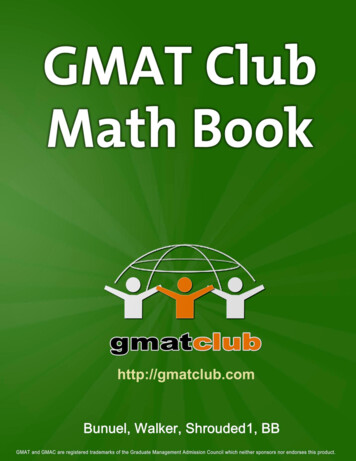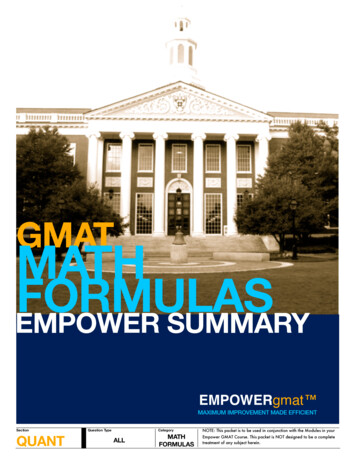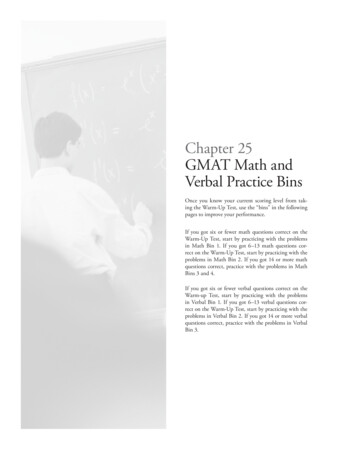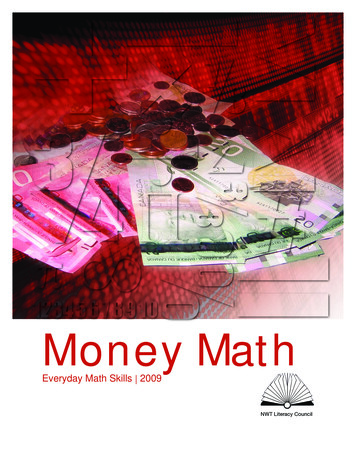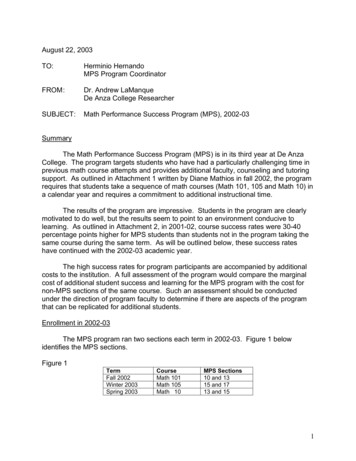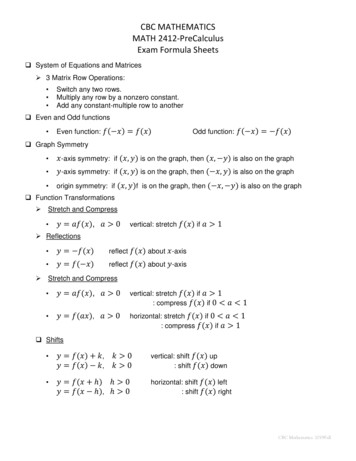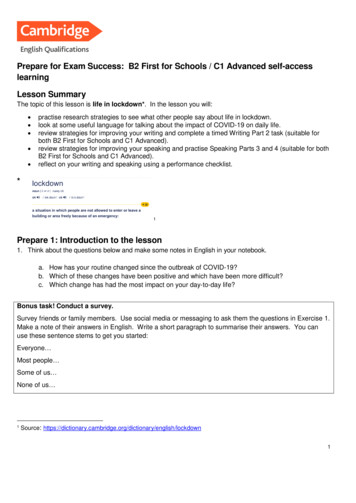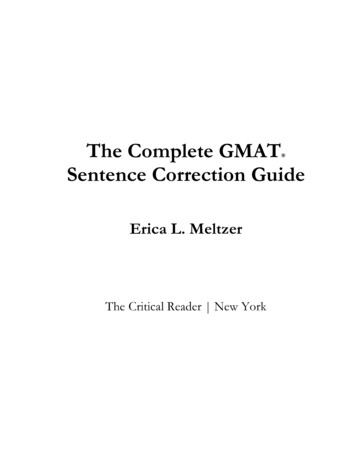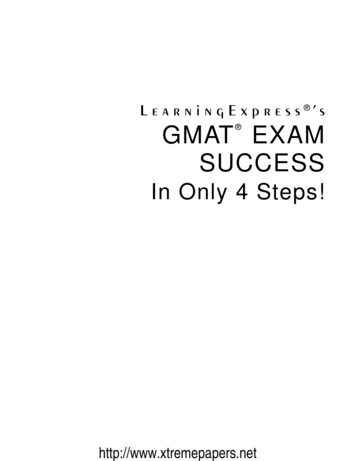
Transcription
L e a r n i n g E x p r e s s ’ s GMAT EXAMSUCCESSIn Only 4 Steps!http://www.xtremepapers.net
L e a r n i n g E x p r e s s ’ s GMAT EXAMSUCCESSIn Only 4 Steps!Elizabeth Cheslaand Colleen Schultz NEWYORK
Copyright 2003 LearningExpress, LLC.All rights reserved under International and Pan-American Copyright Conventions.Published in the United States of America.Library of Congress Cataloging-in-Publication Data:Chesla, Elizabeth L.GMAT exam success in only 4 steps / Elizabeth Chesla and ColleenSchultz—1st ed.p. cm.Includes bibliographical references.ISBN 1-57685-472-81. Graduate Management Admission Test—Study guides.2. Management—Examinations, questions, etc. I. Schultz, Colleen.II. Title.HF1118.C44 2003650'.076—dc212003009065Printed in the United States of America987654321First EditionISBN 1-57685-472-8For more information or to place an order, contact LearningExpress at:55 Broadway8th FloorNew York, NY 10006Or visit us at:www.learnatest.com
About the AuthorsElizabeth Chesla is the author of TOEFL Exam Success, ACT Exam Success, GED Success, Reading Comprehension Success, Write Better Essays, and many other writing and reading guides and test preparation books.She lives in South Orange, New Jersey.Colleen Schultz is a math teacher from Binghamton, New York. She is a contributing writer for 501 MathWord Problems, 501 Quantitative Comparison Questions, and an item writer for several high-stakes math tests.
ContentsPART IPreparing for the GMAT1Chapter 1About the GMAT3Chapter 2Overview of the GMATComputer-Adaptive TestPreparing for the Computer-Based GMAT ExamHow the GMAT Is ScoredGetting Your Scores to SchoolsRetaking the ExamGMAT Testing Center Rules and RegulationsRegistering for the GMAT ExamPaying for the GMAT46791212131620GMAT Study Skills21Where Do I Start?I Need a PlanI Need a PlaceThe Right ToolsThe Study PlanYou Are Worth It: Motivational and Relaxation Techniques that WorkLearning Strategies and Test-Taking TechniquesTesting Psychology2123263031343740vii
–CONTENTS–How to De-StressStay HealthyMultiple-Choice StrategiesThe Endgame41434445PART IIThe GMAT Verbal Section49Chapter 3Verbal Pretest51QuestionsAnswer Explanations5258What to Expect on the GMAT Verbal Section63Reading Comprehension QuestionsCritical Reasoning QuestionsSentence Correction Questions646566Reading Comprehension69Active ReadingFinding the Main IdeaDistinguishing between Fact and OpinionIdentifying Specific Facts and DetailsEssay Types and Organizational PatternsMaking Inferences697276787983Critical Reasoning87Elements of an ArgumentComplicating ArgumentsEvaluating Arguments878993Chapter 4Chapter 5Chapter 6Chapter 7Chapter 8Sentence Correction10924 Rules for Grammar and StyleSentence StructureGrammar and UsageStyle110111119128Tips and Strategies for the Verbal Section137Reading Comprehension QuestionsCritical Reasoning QuestionsSentence Correction Questions138139141viii
–CONTENTS–Chapter 9Verb Forms143Regular VerbsIrregular VerbsHelping VerbsSubjunctive MoodTroublesome VerbsGerunds and Infinitives145146150150151152Prefixes, Suffixes, and Word Roots155PrefixesSuffixesCommon Latin Word RootsCommon Greek Word Roots155160162164Verbal Section Practice Test169QuestionsAnswer Explanations170193Chapter 12Verbal Section Glossary207PART IIIThe GMAT Analytical Writing Assessment211Chapter 13Pretest213QuestionsAnswer Explanations214218About the Analytical Writing Assessment221Analysis of an IssueAnalysis of an ArgumentHow the Essays Are Scored221223225Guide to Effective Writing231The Writing ProcessSeven Steps for Writing a Strong AWA EssayWriting with StyleWriting Correctly: The Conventions of Standard Written English150 Most Commonly Misspelled Words231236248252265Chapter 10Chapter 11Chapter 14Chapter 15ix
–CONTENTS–Chapter 16Tips and Strategies for the AWA267General Writing StrategiesAnalyzing the IssueAnalyzing the Argument267269269AWA Practice271Analysis of an Issue Sample PromptsAnalysis of an Argument Sample PromptsAnswers and Explanations272282292PART IVThe GMAT Quantitative Section305Chapter 18Quantitative Pretest307Problem Solving QuestionsData Sufficiency QuestionsAnswer Explanations308310312About the Quantitative Section317About the Types of Questions318Arithmetic321Types of NumbersProperties of NumbersOrder of OperationsSpecial Types of Defined OperationsFactors, Multiples, and DivisibilityPrime and Composite NumbersEven and Odd NumbersConsecutive IntegersAbsolute ValueOperations with Real nslating Expressions and EquationsCombining Like Terms and PolynomialsLaws of ExponentsSolving Linear Equations of One VariableSolving Literal EquationsSolving Inequalities339340341341342343Chapter 17Chapter 19Chapter 20Chapter 21x
–CONTENTS–Multiplying and Factoring PolynomialsSolving Quadratic EquationsRational Expressions and Equations:Coordinate GraphingSystems of Equations with Two VariablesProblem Solving with Word ProblemsFunctionsChapter 22 nglesQuadrilateralsCirclesMeasurement and Geometry358359360363364365Chapter 23Tips and Strategies for the Quantitative Section367Chapter 24Quantitative Practice Test369QuestionsAnswer Explanations370387Chapter 25Quantitative Section Glossary397Appendix AGMAT Online Resources401Appendix BGMAT Print Resources403xi
P A R TIPreparing forthe GMAT
C H A P T E R1About theGMAT ExamPlanning to apply to a graduate business or management degreeprogram? Then you need to find out all you can about the GMAT exam so you can do your best on the exam. This chapter will tell youeverything you need to know to get started. You will learn how thetest is structured and scored, how to register, and what proceduresand regulations to expect at the testing center.A graduate degree in business or management can transform your professional life, opening the door to promotions, new opportunities, and new careers. For better or for worse, which business school you attenddepends to some degree upon how well you do on the Graduate Management Admissions Test (GMAT ).Like the SAT exam, ACT Assessment , and GRE test, the GMAT exam is a standardized test designedto help schools determine how well you might succeed in their graduate program. Of course, the GMAT examis just one of the tools schools use to assess a candidate’s knowledge and skills, and it is by no means a definitive measure. But it is an important test, and because your scores can determine your eligibility for certainprograms and give you an edge over other candidates, it is important that you do well on the exam.The GMAT exam is sponsored by the Graduate Management Admission Council (GMAC ), a nonprofit association of representatives from business schools around the world. Nearly 2,000 business schoolsuse the GMAT exam, which is developed and administered by the Educational Testing Service (ETS ), thesame organization that develops and administers a number of other standardized tests including the SAT andTOEFL exams. The majority of people taking the GMAT exam seek to enter MBA programs, but an increasing number of other graduate business and management programs are now offered, and many of these programs also use the GMAT exam to assess the qualifications of applicants.3
On the Road to a Graduate DegreeAlthough the MBA is still the most popular graduate business degree, a growing number of other graduate-levelbusiness and management programs are becoming available. Taking the GMAT exam can help you apply forprograms that offer several different graduate degrees, including the following: Master of Business Administration (MBA) Master of Science in Management Master of Public Administration (MPA) Master of Science in Financial Engineering An Over view of the GMAT ExamNearly 50 years ago, the GMAC was founded with the goal it maintains today: to develop a standardizedassessment tool for business school candidates. Although the GMAT exam has evolved over the years, thethree-and-a-half-hour exam still tests candidates in three main areas, measuring analytical writing, verbal,and quantitative skills.The Analytical Writing Assessment (AWA)The first part of the GMAT exam, the Analytical Writing Assessment (AWA), is designed to measure your ability to analyze ideas and to write clearly and effectively about those ideas. You will be asked to write two separate essays: one that analyzes an issue and one that analyzes an argument. You will have 30 minutes for eachessay.In the Analysis of an Issue section, you will be presented with a short passage (one paragraph) aboutan issue, such as whether new technologies create or destroy more jobs or whether education is the mostimportant key to success. You will be asked to take a position on this issue and explain your position. In theAnalysis of an Argument section, you will be presented with a short argument (again, just one paragraph)and be asked to critique that argument. In this essay, you should not present your own point of view but ratherassess the logic of the argument that has been presented.In both cases, the topics will be general enough for every test taker to write about. Prior knowledge ofthe subject matter may be helpful, but it is not required. It is more important to show your ability to take andsupport a position and your ability to analyze the effectiveness of an argument.The Quantitative SectionThe Quantitative section is the second part of the test and includes 37 multiple-choice questions covering twoareas of mathematics: data sufficiency and problem solving. You will have 75 minutes to answer thesequestions.The problem solving questions will constitute approximately 60% of the exam (22 questions). The problems will test your knowledge of basic math facts and skills covered in high school, including arithmetic,4
GMAT Exam Facts Over 1,700 schools/programs use GMAT scores in the admissions process. The first GMAT exam was developed and administered nearly 50 years ago. In 2002, over 150,000 people took the GMAT exam in the United States. In 2002, over 75,000 people took the GMAT exam in locations outside the United States. Nearly 7% more GMAT exams were given in 2002 than in 2001 in the United States. Over 4% more GMAT exams were given elsewhere in the world in 2002 than in 2001. Approximately 20% of people who take the GMAT exam take it more than once. Most repeat testers takethe test two or three times.algebra, geometry, word problems, and interpreting charts and graphs. These questions will emphasize yourunderstanding of mathematical concepts, although you will also need to know basic math procedures in orderto select the correct answer.The data sufficiency questions constitute the remaining 40% of the test and are quite different in nature.For these questions, you do not actually need to solve a problem or make a calculation. Instead, you will bepresented with two items of information and a question. You must determine whether the information presented is sufficient to accurately answer the question or if you need more data to solve the problem. Theanswer choices will ask you to identify which item of information is insufficient if more data is indeedrequired.The Verbal SectionThe third and final part of the GMAT exam is the Verbal section. You will have another 75 minutes to answer41 multiple-choice questions. These questions cover three areas: reading comprehension, critical reasoning,and sentence correction. Approximately one-third of the questions will fall into each category.The reading comprehension questions will be based on short passages (150 to 350 words) about topics ranging from the social sciences to the physical and biological sciences to business, the arts, and humanities. You may be asked about the main idea of the passage, the author’s support for that main idea,argumentative strategies, specific facts and details in the text, and inferences that can be drawn from the passage. You can expect the passages to be rather sophisticated, much like the reading material you will beexposed to in business school.The critical reasoning questions present you with a short reading passage (50 to 100 words) that makesan argument about a general topic. You will be asked about the structure of the argument, including itsconclusion and assumptions; about the quality of the argument, including its strengths and weaknesses; andabout plans of action based upon the argument, including what actions are appropriate and effective basedon the text. Again, this is great training for the business world.The sentence correction questions present you with a sentence with part or all of the sentence underlined. You must choose the answer that best expresses the idea of the sentence. To determine the best answer,you will need to consider the grammar and usage, diction, sentence structure, sentence logic, and tone.5
What the GMAT Exam Is and Is NotLike all standardized tests, the GMAT exam is just one measure of your potential success in a graduate business or management program. A strong correlation can be made between high performance on the GMAT examand success in the first year of business school. However, the exam is designed to measure a targeted set ofknowledge and skills, and does not take into account other factors that are essential to academic success.The GMAT exam is designed to measure the following: your ability to take a position on an issue and support it your ability to critique an argument your ability to organize ideas and convey them clearly in writing your ability to express your ideas in logical, correct, and effective sentences your ability to conduct basic mathematical operations your ability to determine what data is necessary to solve problems, especially those you might encounterin real business situations how well you understand what you read your ability to identify the logic and assumptions behind an argument your knowledge of techniques
Colleen Schultz is a math teacher from Binghamton, New York. She is a contributing writer for 501 Math Word Problems, 501 Quantitative Comparison Questions, and an item writer for several high-stakes math tests. PART I Preparing for the GMAT 1 Chapter 1 About the GMAT 3 Overview of the GMAT 4 Computer-Adaptive Test 6 Preparing for the Computer-Based GMAT Exam 7 How the GMAT Is File Size: 1MBPage Count: 416
